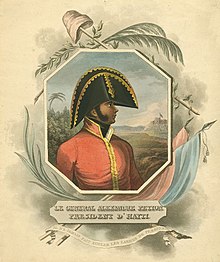Alexandre Sabès Pétion
| Alexandre Pétion | |
|---|---|

Portrait of President Alexandre Pétion
|
|
| 1st President of Haiti | |
|
In office March 9, 1807 – March 29, 1818 |
|
| Preceded by | Jean-Jacques Dessalines (as Emperor of Haiti) |
| Succeeded by | Jean-Pierre Boyer |
| Personal details | |
| Born |
Anne Alexandre Sabès April 2, 1770 Port-au-Prince, Saint-Domingue |
| Died | March 29, 1818 (aged 47) Port-au-Prince, Haiti |
| Nationality | Haitian |
| Spouse(s) | Marie-Madeleine Lachenais |
| Military career | |
| Allegiance |
|
| Service/ |
French Revolutionary Army Armée Indigène |
| Rank | General |
| Battles/wars | Haitian Revolution |
Alexandre Sabès Pétion (French pronunciation: [alɛksɑ̃dʁ sabɛs petjɔ̃]; April 2, 1770 – March 29, 1818) was the first President of the Republic of Haiti from 1807 until his death in 1818. He is one of Haiti's founding fathers, together with Toussaint Louverture, Jean-Jacques Dessalines, and his rival Henri Christophe.
Pétion was born "Anne Alexandre Sabès" in Port-au-Prince to Pascal Sabès, a wealthy French father and Ursula, a free mulatto woman, which made him a quadroon (a quarter African ancestry). Like other gens de couleur libres (free people of color) with wealthy fathers, Pétion was sent to France in 1788 to be educated and study at the Military Academy in Paris.
In Saint-Domingue, as in other French colonies such as La Louisiane, the free people of color constituted a third caste between the whites and enslaved Africans. While restricted in political rights, many received social capital from their fathers and became educated and wealthy landowners, resented by the petits blancs, who were mostly minor tradesmen. Following the French Revolution of 1789, the gens de couleur led a rebellion to gain the voting and political rights which they believed were due them as French citizens; this was before the slave uprising of 1791. At that time, most free people of color did not support freedom or political rights for enslaved Africans and free blacks.
Pétion returned to Saint-Domingue as a young man to take part in the Créole expulsion of the British from Saint-Domingue (1798–99). There had long been racial and class tensions between gens de couleur and enslaved Africans and free blacks in Saint-Domingue, where slaves outnumbered whites and gens de couleur by ten to one. During the years of warfare against planters or grand blancs, Spanish, English, and French racial tensions were exacerbated in competition for power and political alliances.
...
Wikipedia
